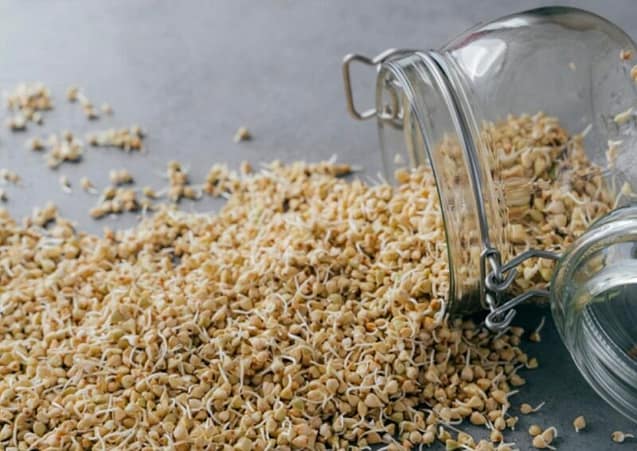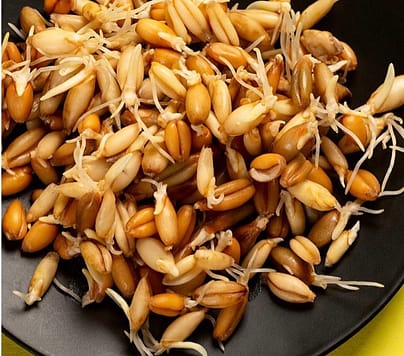The sprouting grains are made easy by doing it at home. Start by soaking organic grains overnight. Rinse and drain daily until sprouts appear, usually within 2-5 days.
I. Introduction
Welcome to our journey into sprouting grains, where health and nutrition meet freshness and control. Discover the natural, vegan, and organic art of home grain sprouting, unlocking a wealth of vitality for your body and soul. In this guide, we'll unveil the secrets of sprouting grains made easy in your kitchen. Aligning perfectly with our dedication to all things natural and sustainable. Get ready to embark on a path towards healthier, more conscious living.
II. Understanding Sprouting
A. What is Sprouting, and Why is it Beneficial?
Sprouting is a natural process where grains, seeds, or legumes are soaked and allowed to germinate, producing young plants. This transformation holds immense benefits for both our health and the environment.
B. Nutritional Advantages of Sprouted Grains
- Enhanced Nutrient Availability: Sprouting activates enzymes that increase nutrient levels. Vitamins, such as B vitamins and vitamin C, become more abundant.
- Improved Digestibility: Sprouting breaks down complex carbohydrates and proteins, making them easier to digest.
- Reduced Anti-nutrients: Anti-nutrients like phytic acid decrease during sprouting. It enhances mineral absorption.
- Amino Acid Profile: Sprouted grains often contain a more balanced amino acid profile, contributing to better protein quality.
C. Eco-Friendly and Sustainable
- Less Water Usage: Sprouting typically requires less water compared to conventional farming of mature plants.
- Reduced Carbon Footprint: Home sprouting reduces the need for transportation, lowering greenhouse gas emissions.
- Minimal Resource Footprint: It's a resource-efficient way to grow nutrient-rich food, aligning with sustainable living.
By harnessing the power of sprouting, we not only boost our nutrition but also tread lightly on the planet, making it a win-win for both personal health and environmental well-being. Check out my separate blog post about the health benefits we get from sprouted grains.
III. Choosing the Right Grains
A. Popular Grains for Sprouting
1. Wheat
Commonly sprouted to make wheatgrass juice or for use in salads and sandwiches.
2. Barley
Rich in fiber and nutrients, great for adding to soups and stews.
3. Quinoa
Nutrient-dense and versatile, suitable for various recipes.
4. Brown Rice
Adds a pleasant crunch to salads and provides added nutrition.
B. Importance of Selecting Organic Grains
Choosing organic grains ( know more about the varieties in my blog post) for sprouting is pivotal for a chemical-free process and aligns with the natural, vegan. Here's why it matters:
1. Purity
Organic grains are grown without synthetic pesticides, herbicides, or genetically modified organisms (GMOs). It ensures that your sprouts remain free of chemical residues.
2. Nutrient Quality
Organic farming practices often lead to higher nutrient content in grains, which further enhances the nutritional benefits of sprouting.
3. Sustainability
Organic agriculture promotes soil health and biodiversity, contributing to a more sustainable food system.
4. Health Benefits
Organic grains are a preferred choice as they avoid harmful chemicals used in conventional farming.
By opting for organic grains in your sprouting endeavors, you ensure a wholesome, chemical-free process that resonates with the values of your website and promotes healthier, eco-conscious living.

IV. Equipment and Ingredients
A. Essential Equipment for Sprouting Grains
1. Glass Jars or Sprouting Trays
Choose wide-mouth glass jars or specialized sprouting trays to provide proper drainage and aeration.
2. Organic Grains
Opt for high-quality organic seeds or grains to ensure a chemical-free sprouting process.
3. Filtered Water
Use filtered or purified water to avoid contaminants that might hinder sprouting.
4. Cheesecloth or Mesh Screens
These allow adequate ventilation while preventing grains from escaping during rinsing.
5. Rubber Bands or Jar Bands
Necessary for securing the cheesecloth or mesh screens in place.
6. Draining Rack or Bowl
To allow excess water to drain from the sprouting containers.
7. Labels and Marker
Keep track of the sprouting progress and grain varieties by labeling your containers.
B. Importance of Using Organic Seeds and Filtered Water
1. Chemical-Free Process
Organic seeds are grown without synthetic pesticides or herbicides, ensuring that your sprouts remain free from harmful chemicals.
2. Nutritional Purity
Organic grains tend to have higher nutrient content and superior quality, which enhances the nutritional benefits of your sprouts.
3. Flavor and Quality
Organic seeds often have better flavor and texture, resulting in tastier and more appealing sprouts.
4. Environmental Considerations
Supporting organic farming practices promotes sustainability and eco-consciousness.
5. Filtered Water
Using filtered water ensures that your sprouts are not exposed to contaminants or chlorine, which can hinder the sprouting process and affect flavor.
By emphasizing organic seeds and filtered water, you maintain the integrity of your sprouting process, produce healthier sprouts, and contribute to a sustainable and chemical-free approach in line with your website's values.
V. Sprouting Grains Made Easy In Step-by-Step Guide
Step 1: Soaking the Grains
- Select Your Grains: Choose your organic grains or seeds. Measure the desired amount for sprouting.
- Rinse: Place the grains in a glass jar or sprouting tray. Rinse them thoroughly under cool, filtered water to remove dust or debris.
- Soak: Add enough water to fully submerge the grains. Allow them to soak for the recommended time, usually 8-12 hours or overnight.
- Drain: After soaking, use a mesh screen, cheesecloth, or the jar's built-in strainer lid to drain the water from the grains. Ensure proper drainage to prevent mold growth.
Step 2: Rinsing and Draining
- Rinse Daily: Rinse the grains under running water, swishing them gently to remove excess starch and promote air circulation. Use filtered water for rinsing.
- Drain Thoroughly: Drain the rinsed grains completely after each rinse. Ensure there's no standing water in the container to prevent mold.
- Frequency: Repeat the rinsing and draining process at least twice a day, preferably in the morning and evening, until sprouts appear.
Step 3: Sprouting
- Monitor Growth: After a day or two of rinsing and draining, you'll notice tiny sprouts emerging from the grains.
- Greening: If you desire green sprouts (e.g., wheatgrass), expose the sprouts to indirect sunlight for a day or two to allow them to turn green.
- Harvest: Once the sprouts have reached the desired length (usually 1-2 inches), they're ready to be harvested.
Step 4: Monitoring and Troubleshooting
- Signs of Trouble: Keep an eye out for any signs of mold, unpleasant odors, or off-color sprouts. If you encounter any issues, discontinue the process and discard the batch.
- Adjust Rinsing Frequency: In warmer weather, you may need to rinse more frequently to prevent drying out. In cooler conditions, reduce rinsing if excessive moisture is an issue.
- Temperature Control: Maintain a consistent room temperature for successful sprouting, ideally between 60-70°F (15-21°C).
Helpful Tips and Insights:
- Quality Matters: Start with high-quality organic seeds or grains for the best results.
- Keep It Clean: Maintain cleanliness in your sprouting equipment to avoid contamination.
- Patience is Key: Sprouting times may vary depending on the type of grain, so be patient and observe your sprouts' progress.
- Storage: Store harvested sprouts in the refrigerator for freshness.
- Experiment: Try different grains and seed varieties to discover your favorite sprouts.
- With these detailed steps, tips, and troubleshooting advice, you're well-equipped to successfully sprout grains at home. Enjoy the freshness and nutrition of your homemade sprouts!
VI. Safety and Hygiene
A. Importance of Cleanliness and Hygiene in Sprouting
Maintaining cleanliness and hygiene throughout the sprouting process is of paramount importance for ensuring the safety and quality of your sprouted grains. Here's why it matters:
1. Preventing Contamination
Any contamination, be it from harmful bacteria or molds, can jeopardize the safety of your sprouts. Clean equipment and good hygiene practices minimize this risk.
2. Food Safety
Since sprouts are often consumed raw, maintaining cleanliness is crucial to avoid foodborne illnesses and ensure the health of consumers.
3. Quality Assurance
Cleanliness directly impacts the quality and taste of your sprouts. Clean sprouting equipment and sanitized hands contribute to the freshest, most flavorful sprouts.
B. Potential Risks and How to Avoid Them
1. Mold Growth
Mold can develop if sprouts remain excessively wet or have poor air circulation. To avoid this:
- Ensure thorough drainage after each rinse.
- Maintain a consistent rinsing schedule to prevent over-soaking.
- Use sanitized equipment to minimize mold spores' introduction.
2. Bacterial Contamination
Harmful bacteria, such as E. coli or Salmonella, can thrive in moist environments. To minimize this risk:
- Wash your hands thoroughly before handling grains or equipment.
- Use sanitized containers and utensils.
- Avoid cross-contamination with other foods.
a. Off Odors
If your sprouts develop an unpleasant odor, it's a sign of spoilage. Discard the batch immediately to prevent any health risks.
b. Temperature Control
Inconsistent temperatures can affect the growth of unwanted bacteria. Keep the sprouting area at a moderate, constant temperature (around 60-70°F or 15-21°C).
c. Stale or Dry Sprouts
Inadequate rinsing can lead to sprouts drying out or becoming stale. Stick to your rinsing schedule to maintain proper moisture levels.
d. Quality Grains
Start with high-quality organic grains or seeds free from contaminants.
By paying meticulous attention to cleanliness and hygiene, you ensure the safety and quality of your sprouted grains and align with the natural, vegan, and organic principles. Safe and healthy sprouts begin with a clean and conscientious approach.

VII. Using Sprouted Grains
A. Culinary Ideas for Sprouted Grains
1. Sprouted Grain Salad
Toss your sprouted grains with fresh veggies, herbs, and a flavorful dressing for a nutritious and crunchy salad.
2. Sprouted Grain Bowl
Create a nourishing grain bowl with sprouted grains as the base, topped with roasted vegetables, avocado, and your favorite protein.
3. Sprouted Grain Wraps
Use large lettuce leaves or collard greens to wrap sprouted grains, hummus, and assorted fillings for a healthy, gluten-free wrap.
4. Sprouted Grain Smoothie
Blend sprouted grains into your morning smoothie (check out my blog post about it) for an added nutrient boost and a thicker texture.
5. Sprouted Grain Bread
Bake your sprouted grain bread or find it at a local bakery for a wholesome and hearty sandwich option.
B. DIY Ideas for Skincare Products
1. Sprouted Grain Exfoliating Scrub
Crush dried sprouted grains into a fine powder and mix with aloe vera or yogurt to create a natural scrub for your skin.
2. Sprouted Grain Face Mask
Blend sprouted grains with honey or mashed avocado to make a revitalizing face mask that can help nourish and brighten your skin.
3. Sprouted Grain Hair Mask
Create a hair mask by mixing sprouted grain powder with coconut oil or yogurt to promote hair health and shine.
C. Nutritional Benefits of Consuming Sprouted Grains
1. Increased Nutrient Availability
Sprouting enhances nutrient bioavailability, making essential vitamins and minerals more easily absorbed by the body.
2. Improved Digestibility
The sprouting process breaks down complex carbohydrates and proteins, potentially reducing digestive discomfort.
3. Enhanced Enzymes
Sprouted grains contain increased enzyme activity, aiding digestion and overall gut health.
4. Rich in Antioxidants
Sprouted grains often have higher antioxidant levels, helping protect cells from oxidative stress.
5. Lowered Anti-Nutrients
Sprouting reduces anti-nutrients like phytic acid, which can hinder mineral absorption.
6. Balanced Amino Acids
Sprouted grains may have a more balanced amino acid profile, making them a valuable protein source.
By incorporating sprouted grains into your meals and skincare routine, you can enjoy their nutritional benefits while exploring creative and natural ways to enhance your well-being. Sprouted grains are a versatile and health-conscious addition to your diet and personal care regimen.
VIII. Frequently Asked Questions
Q1: Why should I consider sprouting grains at home?
Sprouting grains at home ensures freshness, maximizes nutrient content, and allows you to enjoy a cost-effective and sustainable source of sprouted grains.
Q2: What types of grains can I sprout at home?
You can sprout a variety of grains, including quinoa, lentils, mung beans, wheat berries, and more. Experiment with different grains to discover your favorites.
Q3: How do I start the sprouting process at home?
Soak the grains, let them sprout in a cool, dark place, and rinse them regularly. Detailed instructions can be found in our DIY guide to make the process straightforward and enjoyable.
Q4: Are there any tools or equipment needed for sprouting grains at home?
Minimal equipment is required. A jar, cheesecloth or mesh lid, and a bit of patience are the essentials. No fancy gadgets are needed!
Q5: How long does it take to sprout grains at home?
The sprouting time varies depending on the type of grain 7but typically ranges from 1 to 5 days. Our guide provides specific timelines for various grains.
Q6: Can I use sprouted grains in both sweet and savory recipes?
Absolutely! Sprouted grains add a delightful nutty flavor and can be incorporated into a wide range of recipes, from salads and soups to desserts and snacks.
Q7: Are sprouted grains safe to eat raw?
Yes, sprouted grains are safe to eat raw, and many people enjoy them in salads, smoothies, and other uncooked dishes. However, cooking them is also an option depending on your preference.
Q8: Can I store sprouted grains, and if so, for how long?
Yes, store sprouted grains in the refrigerator. They are best consumed within a few days to a week for optimal freshness and
taste.
Q9: Are there any troubleshooting tips for common issues during the sprouting process?
Yes, our guide addresses common challenges, such as mold or uneven sprouting, providing tips to ensure a successful sprouting experience.
Q10: How can I incorporate homemade sprouted grains into my daily meals?
From salads and wraps to smoothie bowls and baked goods, the possibilities are endless. Our blog post includes delicious recipe ideas to inspire your culinary creations.
IX. Additional References
- Sprouts and Microgreens—Novel Food Sources for Healthy Diets (2022) https://www.ncbi.nlm.nih.gov/pmc/articles/PMC8877763/
- Seed Disinfestation Practices to Control Seed-Borne Fungi and Bacteria in Home Production of Sprouts (2023) https://www.ncbi.nlm.nih.gov/pmc/articles/PMC9955435/
X. Conclusion
In the journey of sprouting grains made easy at home, we've unveiled the transformative power of this natural, vegan, and organic process. Let's recap the key takeaways:
- Nutritional Marvel: Sprouting enhances nutrient availability, digestibility, and antioxidant content, making it a nutritional powerhouse.
- Eco-Friendly: Sprouting is not only good for your health but also for the planet. It's a sustainable and resource-efficient way to grow your food.
- Cleanliness is Key: Maintain impeccable cleanliness and hygiene throughout the process to ensure the safety and quality of your sprouts.
- Endless Possibilities: From vibrant salads to revitalizing skincare, sprouted grains offer diverse culinary and DIY opportunities.
Now, it's your turn to embark on this wholesome adventure. Start sprouting grains at home and experience the freshness and vitality they bring to your life.
For more insights on natural, vegan, and organic living, don't forget to explore my website. It's a treasure trove of information, recipes, and products that align with your values and aspirations for a healthier, more sustainable world. Let's sprout together and nurture a brighter, greener future.
XI. My Experience
My experience following this guide on sprouting grains made easy at home, has been nothing short of delightful. The step-by-step instructions made the process remarkably easy to grasp, even for a beginner like myself.
Each day, as I diligently rinsed and drained my grains, I couldn't help but be captivated by the gradual transformation unfolding before my eyes. The excitement of watching tiny sprouts emerge and grow day by day was truly enchanting.
It's a testament to the wonders of nature and the simplicity of sprouting. The anticipation built up until that moment when my sprouts were finally ready for harvest – a satisfying and rewarding culmination of my efforts.
This journey of sprouting grains has enriched my diet with nutrition and added a touch of wonder to my daily routine. It's an experience I highly recommend for anyone seeking a connection to natural, organic, and wholesome living.
Ready to Sprout Your Grains?
Don't miss out on the joys of this natural, vegan, and organic adventure. Follow our guide and start sprouting today! We'd love to hear about your experience and the creative recipes you come up with.
Share your journey with us and be part of our vibrant community dedicated to healthy, sustainable living. Together, we'll cultivate a greener, more nourished world.

 Simple. Natural. Better.
Simple. Natural. Better.